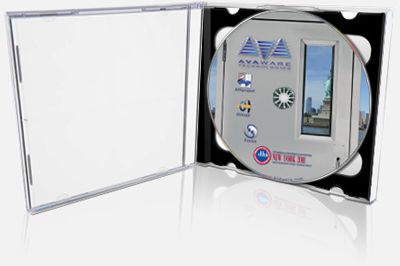
DHI's 36th Annual Conference & Exposition
AVAware Article Featured in October 2011 DHI Magazine
AVAproject Fusion: A Platform for the Future
contractERP Export Enhancements
Social Networking Connects the Architectural Openings Industry
AVAproject Tip: Creating an Openings Index: Using the Special Function Columns

 U.S. Price Books: U.S. Price Books:
 Canadian Price Books: Canadian Price Books:
|

|

|
|
|

|
After the brief article we published last month regarding this year’s DHI Convention, we were pleasantly surprised to hear from so many of our friends and clients that have decided to make the trip to New York. Whether it’s the lure of Manhattan night life, or the prospect of spending two days immersed in door and hardware ecstasy, it seems that many more people than expected have decided to make an appearance.
|
|
As we stated in last month’s AVAwire, the DHI Convention is our one annual opportunity to meet with many of our valued clients face-to-face. As such we make as much an effort to make our presence beneficial to them, as we do courting new prospects. This year we’ve planned a number of things that will be of interest to current and new AVAware clients alike.
The Annual AVAware-DHI CD
Each year we compile a number of resources from our website and development team and put them together on a CD that we distribute during the show. This year’s CD
|
contains a number of articles ranging from new product overviews to technical papers. In addition, we’ve collected a series of “BIM tools” that are being offered as a companion to the article we submitted for the October 2011 issue of DHI Magazine. For those that are not familiar with AVAware products, the CD also contains detailed product information and sample reports.
Industry Marketplace
Once again, AVAware will be taking part in the DHI Convention’s Industry Marketplace on the morning of October 26th. There are two sessions scheduled for that morning and at this point we’ve
|
decided to adopt an open-format and leave the substance of the sessions to be determined by the attendees.
We have a number of topic areas available for discussion ranging from product reviews, user Q&A and new product demonstrations. Since so many attendees are yet uncertain about their specific travel plans, we plan to tailor each session to the requests of the attendees.
Some of the presentations we are prepared to offer are: - AVAproject & AVAcad - Product Overview
- AVAproject & AVAcad - New Features for 2012
- AVAproject Fusion - Product Overview
|
|

|
The AVAware presentations will be held in room 1E-02 on level 1 of the convention center. We look forward to welcoming our current AVAware users as well as those seeking information about our products.
To all those who plan to be in attendance, we look forward to seeing you in New York!
|
|
AVAware Article Featured in October 2011 DHI Magazine
|

|
The architectural openings industry's premier publication, Doors & Hardware Magazine, featured yet another article from AVAware in its October 2011 issue.
"BIM and the Architectural Openings Industry", authored by AVAware President & CEO Paul Kirsch, explores the implications and impacts of BIM technologies on the architectural openings industry and specifically the distributors of its products.
For those interested in further exploring BIM technology, AVAware has assembled a collection of utilities and sample files that will provide a
|
|
|
AVAproject Fusion: A Platform for the Future
|

|
Even though AVAproject Fusion is now feature-complete, this is only the beginning of the road for our development team. In order to build such a comprehensive data harvesting and reporting product, we’ve had to create an incredibly powerful collection of data access tools which will become the foundation of even more new products yet to come.
|
|
As the name implies, “Fusion” is about combining elements. In this case, we’re referring to separate applications. The common foundation of many business tools is data access and manipulation. Virtually every business task involves some element of data retrieval followed by its manipulation and eventual reporting. This holds true for everything from detailing and estimating to accounting. If there are two things that Fusion is exceptionally good at, they’re retrieving data and reporting on it.
AVAware has planned an extremely aggressive development schedule for the next year. On the heels of the recent Fusion release, there are several additional product releases planned for the next few months; many of them build upon Fusion technology and extend the product’s functionality across the enterprise.
|
Fusion Accounting Interfaces
The first Fusion-based add on product planned for release this year is the Fusion Accounting Interface. As its name suggests, it allows data harvested from the project files to be exported into the users’ choice of accounting package. The interface software does far more than just an export however; before any data is sent to the accounting system, users are given the opportunity to selectively extract project data, for billing and purchasing purposes, based on virtually any criteria. Products can be selected by opening, phase, manufacturer or any other piece of data contained in the project. This incredible flexibility is made possible by leveraging the powerful Filter Builder component of Fusion.
In the interest of offering our customers the widest range of choice possible, it is
|
our goal to create export “modules” to as many different accounting packages as possible. Since the majority of the data extract/export process occurs regardless of which accounting package has been selected, supporting different programs is generally just a matter of creating program-specific export modules for the final phase of the process. Modules will be developed based on popularity with customers; the first accounting programs to be supported will be Intuit Quickbooks and Sage Peachtree.

Please continue to monitor the AVAware website and future editions of AVAwire for ongoing news about Fusion-based product development and accounting system support.
|
contractERP Export Enhancements
|

|
Users of AVAproject and contractERP can look forward to an enhanced export module that brings new functionality to process.
|
|
For those that haven’t heard of it, contractERP is an ERP / accounting system developed and marketed by Access Information Technologies (Access IT) of Farmingdale, NY. ContractERP is built on top of Microsoft’s Navision product and has been used by AVAware customers since 2004.
In the past, third party developers facilitated the connectivity between these two applications. As time went on, the number of AVAware customers that adopted contractERP had grown. In response to this and requests from many of the users themselves, AVAware developed our own contractERP export facility for use with AVAproject.
Since those early days, the number of AVAproject / contractERP users has grown considerably and today, AVAware is one of, if not “the” most widely used detailing and estimating systems used by contractERP customers. AVAproject users make up a significant portion of contractERP’s entire customer base, and is used by some of their largest customers in both the United States and Canada. As such, it is only fitting that we take the initiative to help
|
enhance the integration between these two successful applications.
Traditionally, AVAproject has performed a straight export of project data into contractERP with no attempt to modify the nature of it whatsoever. After several discussions with and based on feedback from some of our common clients, AVAware’s developers have come up with a number of ways in which the contractERP export facility could be enhanced to provide additional options for contractERP users.
The new optional module has its own setup dialog that provides access to the inline data filters. The first utility supplements the exported data with the full English counterparts for the nomenclature used in the openings schedules. Since product codes can vary dramatically from one manufacturer to another; the export module now takes the corresponding language directly from the catalog used for each particular opening. As an example, “PG” means “Paintable Galvanneal” from one manufacturer and “Paint Grade” from another. The export module will make the appropriate
|
selection based upon the context in which it is used in the project. There is no limit to the number of manufacturers that can be used in a given project and the data can be drawn from all installed catalogs. The descriptions that are exported are the same ones that currently appear on the “Index of Abbreviations” page of the submittal package.
Other data filters allow for the overriding and replacements of various elements of product data, codes and descriptions. The initial set of enhancements also provides a framework on which we can continue to build functionality as it’s required by users.
The new export module is currently being beta tested by a small group of AVAproject / contractERP users and will be available in the next release of AVAproject. In the interim, should any other current users have suggestions for other enhancements we could make to the export facility, please forward your comments to our customer support department.
|
Social Networking Connects the Architectural Openings Industry
|

|
Social Networking sites like Facebook, Twitter, Linked In and the new Google Plus have become the hottest emerging trend in personal computing since the internet itself. “The Social Network” was a hit film that detailed the origins of Facebook and the life of its creator Mark Zuckerberg; Beyond entertaining us, it demonstrated that social networking was now a undeniable reality of everyday life.
|
|
As the name implies, “social networking” is means by which individuals are able to connect and communicate via the internet. Brought together by virtually anything from interests to careers, people from virtually all walks of life have found at least one online venue on which to share ideas with those they perceive as their peers.
Although these sites have received a great deal of mainstream notoriety in recent years, the history of social networking dates back to before the “world wide web” or the internet as most know it, even existed. In as far back as the 1970s, computer engineers and early software developer used tools such as IRC (Internet Relay Chat) or BBS (Bulletin Board Systems) to keep in touch with distant peers. Since then, dozens have come and gone. Many will remember services
|
such as Compuserve, AOL, CU-SeeME and many more. While many smaller sites have found their niches with specific interest groups and continue to thrive, only a handful have truly grown into the giants we hear about nearly every day.
Virtually every major brand’s advertisement now tells us to “like us on Facebook” or “follow us on Twitter”. With all these new verbs being thrown at us today, it seems impossible to stay “in the loop” if you’re not a part of one of those little blue icons. Invariably, however, even these mainstream titans seemed to have found their niches. Facebook, for example, is clearly a “personal” venue that often contains photos and narratives that one would never want shared in their professional lives. In fact, there have been stories of embarrassing moments when employers have caught their people in
|
lies as a result of posts to their Facebook pages. Even Facebook themselves publishes reminders of the fact that material posted online is available for public consumption.
The internet community has always demonstrated that they are quick to identify and fill needs wherever they are perceived. A clear example of this is a Facebook-type service, called Linked In. Just as Facebook is designed to document and connect your personal life, Linked In is designed to do the same for your professional one. Unlike Facebook which calls upon its users to build up lists of “friends”, Linked In has chosen the more professional sounding “connections” to call the members of its users’ contact lists. At the end of the day, it amounts to much the same thing; the site becomes an online popularity contest where all the users essentially compete with their peers to
|
|
see who can accumulate the greatest number of “connections”. One area in which the two do differ, however, is cost. While Facebook proudly boasts the tag line “It’s free and always will be”, Linked In does not. Yes, there is a basic “no charge” account level in Linked In, but users are quickly and often prompted to upgrade to premium levels to access information with greater detail. Although there are a few choices of access level, the monthly cost can get significant.
The basic premise behind Linked In is essentially very good. The user directory can be searched by name, and company as well as skills and qualifications. If one were looking for an individual with a specific skill set, the service would quickly let you know if there was a “friend of a friend” that you didn’t know you had that could fit the bill.
In addition to connecting individuals, the service hosts a variety of special interest discussion “groups” that can be joined and monitored. These
|
groups provide access to even more “connections” to people that share common interests. Even theDoor and Hardware Institute (DHI) has two groups on Linked In; one is public, meaning anyone can join immediately, while the other is a “members only” group that requires users to request access. The admission process is quick, presumably a group moderator verifies that the applicant is actually a DHI member and then grants them access to the discussions.
The truly astonishing thing about Linked In, and the reason for this article, was the dozens (if not hundreds) of people from the architectural openings industry that seemed to have found their way online. If you’re not a member yet, you might consider giving Linked In a look. Begin by creating an account for yourself and then searching for companies and people you deal with regularly. Each time to “make a connection” with someone, you inherit limited access to their list of connections as well. It doesn’t take long to realize how quickly your “connection”
|
list begins to grow.
One final word of advice; any social network is only as valuable as the contributions made by its members. Many people simply create an account and proceed to grow their “friends” or “connection” list as though it were some sort of online game. If this is the extent of your online activity, then the site is reduced to the equivalent of an online phone book. Take advantage of the opportunity that social networking offers to post ideas, share insights and engage in dialogs with your friends and peers. Never in human history has it been possible for someone to address so large a group, put themselves in front of such a large audience instantly. This is truly the kind of publishing power that people like Johannes Gutenberg could have only dreamt of. While you contemplate the power at your fingertips, also remember that everything you post is visible to others immediately. There is no way to put that virtual genie back in the bottle; consider carefully everything you put out there.
|
|
One of the most impressive features of AVAproject is its ability to compile all the assorted components of a given project into a single, formatted submittal package in a single ‘click’. When a submittal document is created, a number of processes occur in the background; among them are the following:
- An internal “Material List” is generated to coordinate the openings with their assigned hardware and to create a component list.
- Frame profiles are automatically created for each individual piece of frame material.
- Elevations are created as required for openings that do not have AVAcad drawings associated with them.
- A Hardware Schedule is generated both for presentation and to establish a list of required catalog cuts.
- Other various sections are created as required.
All the separate elements of the submittal package are all indexed to each other; this facilitates the automatic creation of a complete index coordinating each opening to its associated elevation, profiles and appearance in the Hardware Schedule. This indexing is done through the use of special function columns within the Openings Schedule. In the August 2011 edition of AVAwire the ‘tip’ focused on the “Second Num.” column and how it can be used to refer each opening to its corresponding section details; a similar functionality is available in other columns as well.
When the submittal is generated, the following columns are automatically populated:
Elevation: |
AVAproject automatically creates elevations for a variety of standard frame types. If this column is left blank, it is populated with the name of the auto-generated elevation that corresponds to the opening.
|
Heading Num.: |
The Hardware Schedule is automatically generated based on the Hardware Groups associated with each individual opening. Openings are arranged into headings based on the option settings for the given project. Since changes to any of the options that govern this process can result in a rearrangement of the openings and heading, the actual Heading Numbers are given to changing. When the submittal is generated, this column is populated with the actual Heading Number in which the given opening appears in the Hardware Schedule.
|
Section Num.: |
As discussed in the August 2011 AVAwire, this column is populated with the unique section numbers that correspond to frame material utilized in the given opening.
|
By including some or all of these columns in the printed Openings Schedule, an “index” is created to guide the reader between the various sections of the submittal package. The following is a sample of an “Openings Index” view style that is preloaded with AVAproject. The first image shows the view style as it appears on the project screen; note the highlighted columns are currently blank.

The AVAproject Openings Schedule editor with relevant openings index columns shown
The following is the same Openings Schedule as it appears in the completed Submittal Package; note the special function columns have been automatically populated.

A print preview of the same Openings Schedule. Note the automatic population of the Openings Index columns
|
|
|
We welcome any questions, comments or suggestions about any topic mentioned in this edition of AVAwire. Please visit our website for more information, or contact us directly at (416) 239-9099.
|
|